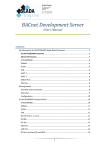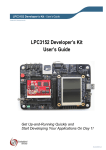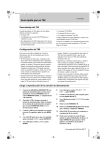Download GESBC-3130 User`s Manual
Transcript
Embedded Single Board Computer
GESBC-3130
User’s Manual
GESBC-3130 User’s Manual
Table of Contents
Chapter 1 – Introducing the GESBC-3130 Single Board Computer ................................................. 4 GESBC-3130 Overview................................................................................................................. 4 Advanced Features ......................................................................................................................... 4 LPC-3130 ....................................................................................................................................... 5 SDRAM ......................................................................................................................................... 5 FLASH ........................................................................................................................................... 5 USB ................................................................................................................................................ 5 UART............................................................................................................................................. 5 Ethernet .......................................................................................................................................... 5 Chapter 2 – Getting Started................................................................................................................ 6 Assembly and Connections ............................................................................................................ 6 Operation........................................................................................................................................ 6 Configurations................................................................................................................................ 8 Chapter 3 – GESBC-3130 Function Blocks ...................................................................................... 9 LPC-3130 ....................................................................................................................................... 9 SDRAM ......................................................................................................................................... 9 FLASH ........................................................................................................................................... 9 USB .............................................................................................................................................. 10 RS-232 Port.................................................................................................................................. 10 I2C Bus, SPI Bus, PWM output .................................................................................................. 10 Ethernet ........................................................................................................................................ 10 USB Port ...................................................................................................................................... 11 A/D Converter .............................................................................................................................. 11 GPIO ............................................................................................................................................ 11 Real Time Clock (RTC) ............................................................................................................... 11 JTAG ............................................................................................................................................ 12 Power Requirement ...................................................................................................................... 12 Chapter 4 – Software Description .................................................................................................... 13 Overview ...................................................................................................................................... 13 Data Storage on GESBC-3130..................................................................................................... 13 GESBC-3130 Linux Code ........................................................................................................... 13 U-boot .......................................................................................................................................... 13 U-boot Booting Linux .................................................................................................................. 13 Loading Linux Kernel and root File System................................................................................ 14 Chapter 5 – Development Tools ...................................................................................................... 16 Overview ...................................................................................................................................... 16 Linux Development Tool Chain .................................................................................................. 16 Chapter 6 – Troubleshooting ........................................................................................................... 18 Version 1.0
Page 2 of 18
20-Jun-11
GESBC-3130 User’s Manual
List of Tables
Table 1 Boot Mode Configuration ..................................................................................................... 8 Table 2 UART Port CON8 Connector on GESBC-3130................................................................ 10 Table 7 CON2 I2C bus, SPI bus, PWM output .............................................................................. 10 Table 7 CON9 A/D input ................................................................................................................ 11 Table 9 CON1 GPIO ....................................................................................................................... 11 Table 10 CON7 JTAG Connector.................................................................................................... 12 Table 11 CON11 Power Supply Connector ..................................................................................... 12 Table 12 NAND FLASH Storage Map ............................................................................................ 13 Version 1.0
Page 3 of 18
20-Jun-11
GESBC-3130 User’s Manual
Chapter 1 – Introducing the GESBC-3130 Single Board
Computer
GESBC-3130 Overview
The GESBC-3130 is a low cost compact sized single board computer based on NXP LPC-3130
processor. With a large peripheral set targeted to a variety of applications, the GESBC-3130 is
well suited for industrial controls, digital media servers, audio jukeboxes, thin clients, set-top
boxes, point-of-sale terminals, biometric security systems, and GPS devices.
Advanced Features
The heart of the GESBC-3130 is the LPC-3130 which is the one in a series of ARM926EJ-S-based
processors. The NXP LPC3130 combines an 180 MHz ARM926EJ-S CPU core, high-speed USB
2.0 On-The-Go (OTG), up to 192 KB SRAM, NAND flash controller, flexible external bus
interface, four channel 10-bit ADC, and a myriad of serial and parallel interfaces in a single chip
targeted at consumer, industrial, medical, and communication markets.
The list below summarizes the features of the GESBC-3130.
•
•
•
•
•
•
•
•
•
•
•
•
•
180MHz Processor Core – ARM926EJ-S with MMU
32 MB SDRAM
128MB NAND FLASH
1 10/100 Mbps Ethernet port
4 channel 10-bit Analog-to-Digital Converter (ADC
RS-232 Universal Asynchronous Receiver / Transmitters (UART)
High speed USB OTG Port
Real-Time Clock with battery backup
Hardware Debug Interface
SD/MMC Socket
GPIO Ports
1 I2C Ports
1 SPI Port
Figure 1 below shows a picture of the GESBC-3130 Single Board Computer.
Version 1.0
Page 4 of 18
20-Jun-11
GESBC-3130 User’s Manual
Figure 1. GESBC-3130 Single Board Computer
LPC-3130
The GESBC-3130 is shipped with the NXP LPC-3130 processor. For more information regarding
the LPC-3130 processor please see the LPC-3130 datasheet.
SDRAM
The GESBC-3130 is shipped with 32MBytes of SDRAM.
FLASH
The GESBC-3130 is shipped with 128MB NAND FLASH.
USB
The GESBC-3130 is shipped with high speed USB OTG port.
UART
The GESBC-3130 is shipped with a full RS-232 interface with modem control signals
Ethernet
The GESBC-3130 is shipped with 10/100 BASE-T Ethernet port.
Version 1.0
Page 5 of 18
20-Jun-11
GESBC-3130 User’s Manual
Chapter 2 – Getting Started
This chapter describes the GESBC-3130 working environment and familiarizes the user with its
components and functionality. This chapter contains the following sections:
•
Assembly and Connections
o Describes how to assemble and connect components to the GESBC-3130 Single
Board Computer
•
Operation
o Describes how to operate the GESBC-3130 Single Board Computer
Assembly and Connections
In order to use the GESBC-3130 the user must first assemble and connect the peripherals to the
GESBC-3130, as described in the following procedure.
1. Place the GESBC-3130 on a static free surface.
2. Make sure all of the jumpers are in the factory default position. The unit is shipped in a
factory default configuration. If the user is uncertain that the GESBC-3130 has the jumpers
in the factory default configuration, please see the next section regarding board
configuration.
3. Connect 5V regulated power supply to J1 on the board.
4. Connect null modem serial cable between GESBC-3130 debug port and PC/terminal serial
port.
5. Launch a terminal emulator, such as HyperTerminal, or minicom, on the PC configured to
connect to the serial port of the GESBC-3130. Configure the serial port with the following
parameters: 115200 bits per second, 8 data bits, no parity, 1 stop bit, no flow control.
6. Connect the board to a local area network (optional)
Operation
A few seconds after applying power to the GESBC-3130, debug information will be displayed on
the terminal program. The following figures show what this should look like.
Version 1.0
Page 6 of 18
20-Jun-11
GESBC-3130 User’s Manual
Please see
Version 1.0
Page 7 of 18
20-Jun-11
GESBC-3130 User’s Manual
Chapter 4 – Software Description for more details regarding the software functionality.
Configurations
The GESBC-3130 has multiple boot mode. It can boot from SD/MMC card, USB port, UART, or
on-board NAND FLASH. Jumpers are used to configure the GESBC-3130 to boot in different
modes. The following table lists all the settings for each boot mode.
JP2
L
L
H
L
Version 1.0
JP3
L
H
H
H
Table 1 Boot Mode Configuration
JP4
Boot Mode
L
NAND FLASH boot
H
SD/MMC card boot
L
UART boot
L
USB boot
Page 8 of 18
20-Jun-11
GESBC-3130 User’s Manual
Chapter 3 – GESBC-3130 Function Blocks
LPC-3130
The GESBC-3130 Single Board Computer uses the NXP LPC-3130 as the core processor on this
development board. The top-level features of LPC-3130 processor are the following:
•
ARM926EJ-S RISC Core Processor
•
180MHz
•
16Kbyte Instruction Cache
•
16 Kbyte Data Cache
•
MMU
•
100 MHz System Bus
•
16 bit SDRAM Interface
•
8/16 bit SRAM / FLASH / ROM Interface
•
Fast UART
•
High Speed USB OTG Port with on-chip Physical
•
4 channel 10 bit ADC
•
SPI Port
•
2 I2C Port
•
Serial Audio Interface
•
General Purpose I/O Pins (GPIO)
•
JTAG Interface
More detailed information regarding the LPC-3130 processor can be found at www.NXP.com.
SDRAM
The GESBC-3130 is shipped with 32MB SDRAM. It occupies memory location from 0x30000000 to 0x31FF-FFFF.
FLASH
The GESBC-3130 is shipped with 128 Mbytes of NAND FLASH memory.
Version 1.0
Page 9 of 18
20-Jun-11
GESBC-3130 User’s Manual
USB
The GESBC-3130 Single Board Computer provides one high speed USB OTG port. The USB OnThe-Go block enables usage in both device mode and in host mode. This means that you can
connect to a PC to exchange data, but also to another USB device such as a digital camera or MP3
player. The USB port are brought out by a USB type A/B mini connector.
RS-232 Port
The GESBC-3130 Single Board Computer is shipped with one fast RS-232 UART interface. The
fast UART on the GESBC-3130 serves as a debug port by U-boot and Linux kernel. The UART
connector is the DB-9 connector on GESBC-3130. The signal designation is listed in the
following table.
Pin Number
1
3
5
7
9
Table 2 UART Port CON8 Connector on GESBC-3130
Signal Name
Pin Number
Signal Name
NC
2
RX
TX
4
NC
GND
6
NC
RTS
8
CTS
NC
10
N/A
I2C Bus, SPI Bus, PWM output
The GESBC-3130 Single Board Computer provides one I2C bus interface, one SPI bus, and one
PWM output on connector CON2. The I2C bus on the CON2 is the I2C1 on the LPC-3130
processor.
Table 3 CON2 I2C bus, SPI bus, PWM output
Pin Number
Signal Name
Pin Number
1
SDA
2
3
SCL
4
5
PWM output
6
7
3.3V
8
9
GND
10
Signal Name
SPI CS
SPI CLK
SPI MISO
SPI MOSI
SPI CS_IN
Ethernet
The GESBC-3130 Single Board Computer is shipped with support for a complete Ethernet
interface. The Media Access Controller (MAC) supports 1/10/100 Mbps transfer rates and
interfaces to industry standard physical layer devices.
Version 1.0
Page 10 of 18
20-Jun-11
GESBC-3130 User’s Manual
USB Port
The GESBC-3130 Single Board Computer is shipped with a high speed USB OTG port on a USB
mini A/B USB OTG connector.
A/D Converter
The GESBC-3130 Single Board Computer provides 4 channel 10 bit A/D converter. A 6pin
2.54mm spacing header provides the 4 A/D input channel.
Table 4 CON9 A/D input
Pin Number
Signal Name
1
A/D 1
2
A/D 2
3
A/D 3
4
A/D 4
5
GND
6
GND
GPIO
The GESBC-3130 is shipped with 16 configurable general purpose input/output (GPIO) ports.
Each GPIO port can be configured to have pull-up, pull-down or repeater mode. The signal
assignment is listed in the following table
Table 5 CON1 GPIO
Pin
1
3
5
7
9
11
13
15
17
19
Signal
3.3V
GPIO 3
GPIO 5
GPIO 7
GPIO 9
GPIO 11
GPIO 13
GPIO 15
GPIO 17
GND
Pin
2
4
6
8
10
12
14
16
18
20
Signal
3.3V
GPIO 4
GPIO 6
GPIO 8
GPIO 10
GPIO 12
GPIO 14
GPIO 16
GPIO 18
GND
Real Time Clock (RTC)
The GESBC-3130 is shipped with a real time clock (RTC) with battery hook-up to provide
accurate time keeping. The on-board battery holder accepts CR1225/CR1220 coin cell batteries.
Version 1.0
Page 11 of 18
20-Jun-11
GESBC-3130 User’s Manual
JTAG
The GESBC-3130 Single Board Computer is shipped with a 10 pin connector that provides JTAG
debug signals for the CPU. The JTAG provides the user with the ability to debug system level
programs. The signal designation is listed in the following table.
Pin Number
1
3
5
7
9
Table 6 CON7 JTAG Connector
Signal Name
Pin Number
Signal Name
3.3V
2
NC
NTRST
4
N_RESET_IN
TDI
6
TDO
TMS
8
NC
TCK
10
GND
Power Requirement
The GESBC-3130 Single Board Computer requires regulated 5V DC. The power supply should
have minimum 250mA capacity.
Table 7 CON11 Power Supply Connector
Pin Number
Signal Name
1
5V DC
2
GND
Version 1.0
Page 12 of 18
20-Jun-11
GESBC-3130 User’s Manual
Chapter 4 – Software Description
Overview
This chapter provides information regarding the software that is shipped with the GESBC-3130
Board. The software included with the board is U-boot boot loader, Linux kernel 2.6.33.14, and
Debian distribution style compact root file system. The applications included provide access to all
hardware functions on the GESBC-3130 board.
Data Storage on GESBC-3130
The default configuration of the GESBC-3130 Single Board Computer uses on board NAND
FLASH for all data storage requirements, including boot strap code, boot loader, Linux kernel, and
Linux file system.
The following table is the storage map on the NAND FLASH.
Table 8 NAND FLASH Storage Map
Start Address
Size
Usage
0x00000000
0x20000
Boot strap code
0x00020000
0x40000
U-boot
0x00060000
0x40000
U-boot primary environment storage range
0x000A0000
0x40000
U-boot secondary environment storage range
0x00100000
0x300000
Linux kernel
0x00400000
-Root file system
GESBC-3130 Linux Code
The GESBC-3130 is shipped with Linux 2.6.33.14 kernel pre-installed. This software is
programmed into the system FLASH located on the board prior to shipment. The Linux kernel is
configured with all the device drivers included for the GESBC-3130 board.
U-boot
U-boot provides a simple interface for loading operating systems and applications onto the
GESBC-3130 board. U-Boot uses a serial console for its input and output. The default serial port
setting is 115200,8,N,1. It also supports the built-in Ethernet port and general flash programming.
The board is shipped with U-boot pre-installed. Please refer to U-boot user’s manual regarding
detailed information of U-boot.
U-boot Booting Linux
The following shows the default U-boot setup for booting Linux.
Version 1.0
Page 13 of 18
20-Jun-11
GESBC-3130 User’s Manual
GESBC-3130 # printenv
bootcmd=run nand_boot
bootdelay=3
baudrate=115200
bootfile=uImage
loadaddr=0x31000000
rd_addr=0x32000000
usbtty=cdc_acm
ramargs=setenv bootargs console=ttyS0,115200n8 root=/dev/ram0 rw
ip=dhcp loglevel=7
nfsargs=setenv bootargs console=ttyS0,115200n8 root=/dev/nfs rw
nfsroot=${serverip}:${rootpath} ip=dhcp loglevel=7
rootpath=/tftpboot/arm
bootfile=uImage
usb_boot= usb start; fatload usb 0 $(loadaddr) $(bootfile); run
nandargs; bootm $(loadaddr)
uart_boot= loady; run nfsargs; bootm $(loadaddr)
uartram_boot= loady; loady $(rd_addr); run ramargs; bootm $(loadaddr)
$(rd_addr)
ethaddr=00:08:9e:d1:bd:6a
ethact=dm9000
nandargs=setenv bootargs console=ttyS0,115200n8 root=/dev/mtdblock2
rw rootfstype=jffs2 mtdparts=lpc313x_nand:1M(boot),3M(kernel),-(fs)
filesize=20423C
fileaddr=31000000
ipaddr=192.168.1.200
serverip=192.168.1.199
nand_boot=nand read $(loadaddr) 0x100000 0x300000;run nandargs; bootm
$(loadaddr)
Environment size: 916/131068 bytes
The bootcmd setting of the U-boot reads the Linux kernel from NAND FLASH at address
0x100000 to SDRAM at address 0x31000000 and start executing the kernel code at the same
memory address. The NAND FLASH from 0x400000 and up is used for Linux root file system.
The U-boot passes the MTD device partition setting to the Linux kernel via the bootargs
environment variable.
Loading Linux Kernel and root File System
The U-boot boot-loader provides many ways to load Linux kernel and file system into FLASH
memory. The loading by Ethernet network is shown here. User can consult U-boot manual for
other methods of loading data.
After power on the GESBC-3130 board, stop the U-boot auto-execution by press any key. The
following message should be shown on the terminal console on the host PC connected to the
GESBC-3130 board.
Version 1.0
Page 14 of 18
20-Jun-11
GESBC-3130 User’s Manual
The net work address and server address must be set before network transfer can take place. The
following commands will set the SBC IP address and server IP address,
set ipaddr xxx.xxx.xxx.xxx
set serverip xxx.xxx.xxx.xxx
The server IP is the IP address where a TFTP server must be run. To load Linux kernel type in the
following command,
t 0x31000000 uImage
The U-boot will load uImage file from the TFTP server whose IP address is specified by the
serverip environment vairbale.
The NAND FLASH sectors must be erased first before new kernel image can be stored. The
following command will erase the NAND FLASH sectors reserved for Linux kernel,
nand erase 0x100000 0x200000
The use the flowing command to store the kernel image from SDRAM to NAND FLASH,
nand write.jffs2 0x31000000 0x100000 0x200000
The following commands can be used to load root file system into the FLASH memory,
nand erase 0x400000 0x7c000000
t 0x30000000 rootfs.img
nand write.jffs2 0x30000000 x0400000 $(filesize)
Please be noted that the image is first loaded into the SDRAM and then stored into the FLASH
memory. The image size can not exceed the available SDRAM on the board.
After the kernel and root file system have been updated the board can be simply reboot by recycle
the power.
Version 1.0
Page 15 of 18
20-Jun-11
GESBC-3130 User’s Manual
Chapter 5 – Development Tools
Overview
This chapter provides a brief introduction to development tools that are available for the LPC-3130
System-on-a-Chip processor. The central processing core on the LPC-3130 is a 180 MHz
ARM926EJ-S processor. The ARM926EJ-S RISC processing core is supported through various
toolsets available from third party suppliers. The typical toolset required for the code development
is a compiler, assembler, linker and a source-level code debugger. Code debugging is supported
via the on-chip JTAG interface.
Linux Development Tool Chain
The Linux development tool chain is available at Glomation website in the support page. A host
PC running Linux operating system is required to run the development tools. This guide assumes
user had basic Linux or Unix application development knowledge.
Host Computer Requirement
The host PC should run Redhead, SuSe, or other Linux distribution, a RS-232 serial port, at least
500MB free disk space, and a terminal program such as minicom.
Hardware Connection
A null modem cable is required to connect GESBC-3130 to the host computer.
Install Linux Development Tool Chain
The ARM Linux Development Tool chain can be installed in any directory on the host system.
The following example uses cross compiler default directory /usr/local/arm as the installing
directory for the ARM Linux cross compiler.
1. Login as root and untar the tool chain
cd /
tar jxvf /<cross compiler tar file directory>/ Generic-arm_gcc-4.2.3glibc-2.3.3.tar.bz2
2. Set up the directory path variable
export PATH=/usr/local/arm/gcc-4.2.3-glibc-2.3.3/arm-unknown-linuxgnu/bin:$PATH
Version 1.0
Page 16 of 18
20-Jun-11
GESBC-3130 User’s Manual
above command can be included in the shell resource file so it is executed every time you
login. For bash shell, a good place to put is in .bashrc in your home directory.
Compile Linux Kernel
The GESBC-3130 is shipped with Linux kernel version 2.6.33.14. The patch for the kernel source
tree is available at Glomation website in the support page.
Prepare Linux Kernel source
Obtain the kernel source 2.6.33.14 from http://www.kernel.org. Untar the Linux kernel,
tar xjf
linue-2.6.33.14.bz2
Obtain the kernel patch from http://ics.nxp.com/support/software/lpc313x.bsp.linux/. Patch the
kernel source with the following command,
patch –p1 < /<patch-file-directory-path>/patch_file_name
Configure Linux Kernel
The GESBC-3130 can use the default configuration file for the EA3130 evaluation board.
make ARCH=arm CROSS_COMPILE=arm-unknown-linux-gnu- ea313x_defconfig
If additional configuration is required, executing the following command in the Linux kernel
directory,
make ARCH=arm CROSS_COMPILE=arm-unknown-linux-gnu- menuconfig
If problem occurs, make sure the default PATH variable is set to the correct tool chain directory
Compile Kernel
Once Linux kernel has been configured, it can be compiled using following command,
make ARCH=arm CROSS_COMPILE=arm-unknown-linux-gnu- uImage
The U-boot utility mkimage is required to make the U-boot formatted kernel image files.
Version 1.0
Page 17 of 18
20-Jun-11
GESBC-3130 User’s Manual
Chapter 6 – Troubleshooting
This chapter provides Troubleshooting information. Search the entries in the Problem column in
order to find the item that best describes your situation. Then perform the corrective action in the
same row. If the problem persists, contact Glomation.
Version 1.0
Page 18 of 18
20-Jun-11






























